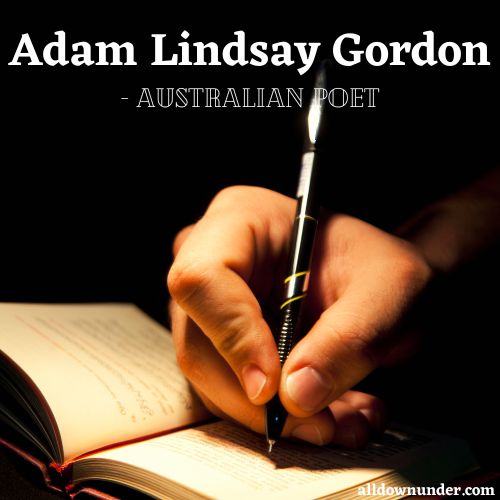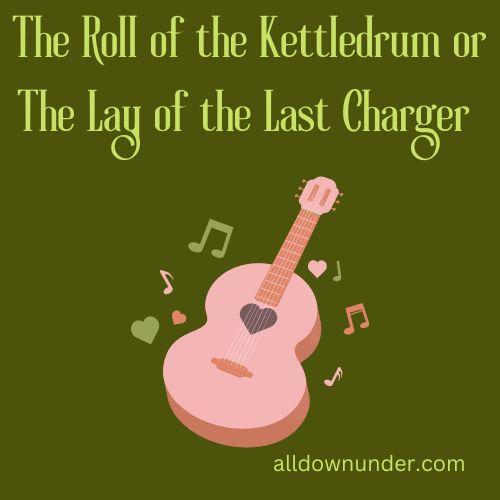Adam Lindsay Gordon was a poet, journalist and publisher who also wrote under his own name and used the pseudonyms Jem Belcher and James Grant. Adam Lindsay Gordon spent part of his childhood in Melbourne and studied at Rugby School in England before returning to Australia in 1851. His journey was during the period 1833 – 1870.
ADAM LINDSAY GORDON WAS born at Fayal in the Azores on 19 October 1833. His father, Captain Adam Durnford Gordon, had married his first cousin, Harriet Gordon, and both were descended from Adam of Gordon of the ballad, and were connected with other distinguished men of the intervening 500 years.
Captain Gordon was then staying at the Azores for the sake of his wife’s health. They were back in England living at Cheltenham in 1840, and in 1841 Gordon went to Cheltenham College. He was there for only about a year. Subsequently he was sent to a school kept by the Rev. Samuel Ollis Garrard in Gloucestershire.
In 1848 he went to the Royal Military Academy, Woolwich. There
he appears to have been good at sports, but not studious and certainly undisciplined. In June 1851 his father was requested to withdraw him and the young man, he was nearly 18, was again admitted a pupil at Cheltenham College. He was not there for long, he appears to have left in the middle of 1852, but the story that he was expelled from Cheltenham is without foundation. He lived for some time with an uncle at Worcester, and was a private pupil of the headmaster of the Worcester Royal Grammar School.
He began to lead a wild and aimless life, contracted debts, and was a great anxiety to his father, who at last decided that his son should go to Australia and make a fresh start. Gordon had fallen in love with a girl of 17, Jane Bridges, who was able to tell the story 60 years afterwards to his biographers. He did not declare his love until he came to say good-bye to her before leaving for Australia on 7 August 1853. “With characteristic recklessness he offered to sacrifice the passage he had taken to Australia, and all his father’s plans for giving him a fresh start in life, if she would tell him not to go, or promise to be his wife, or even give him some hope.” This Miss Bridges could not do, though she liked the shy handsome boy and remembered him with affection to the end of a long life. It was the one romance of Gordon’s life.
That Gordon realized his conduct had fallen much below what it might have been can be seen in his poems …”To my Sister”, written three days before he left England, and “Early Adieux”, evidently written about the same time.
He was just over 20 when he arrived at Adelaide on 14 November 1853. He immediately obtained a position in the South Australian mounted police and was stationed at Mount Gambier and Penola. On 4 November 1855 he resigned from the force and took up horse-breaking in the south-eastern district of South Australia. The interest in horse-racing which he had shown as a youth in England was continued in Australia, and in a letter written in November 1854 he mentioned that he had a horse for the steeplechase at the next meeting.
In 1857 he met the Rev. Julian Tenison Woods who lent him books and talked poetry with him. He then had the reputation of being “a good steady lad and a splendid horseman”. In this year his father died and he also lost his mother about two years later. From her estate he received about £7000 towards the end of 1861. He was making a reputation as a rider over hurdles, and several times either won or was placed in local hurdle races and steeplechases.
On 20 October 1862 he married Margaret Park, then a girl of 17. In March 1864 he bought a cottage, Dingley Dell, near Port MacDonnell, and, in this same year, inspired by six engravings after Noel Paton illustrating “The Dowie Dens 0’Yarrow”, Gordon wrote a poem The Feud, of which 30 copies were printed at Mount Gambier.
On 11 January 1865 he received a deputation asking him to stand for parliament and was eventually elected by three votes to the house of assembly. He spoke several times but had no talent for speaking in public, and he resigned his seat on 20 November 1866.
He was contributing verse to the Australasian and Bell’s Life in Victoria and doing a fair amount of riding. He bought some land in Western Australia, but returned from a visit to it early in 1867 and went to live at Mount Gambier. On 10 June 1867 he published Ashtaroth, a Dramatic Lyric, and on the nineteenth of the same month Sea Spray and Smoke Drift. In November he rented Craig’s livery stables at Ballarat, but he had no head for business and the venture was a failure.
In March 1868 he had a serious accident, a horse smashing his head against a gatepost of his own yard. His daughter, Annie Lindsay Gordon, born on 3 May 1867, died at the age of 11 months, his financial difficulties were increasing, and he fell into very low spirits.
In spite of short sight he was becoming very well known as a gentleman rider, and on 10 October 1868 actually won three races in one day at the Melbourne Hunt Club steeplechase meeting. He rode with great patience and judgment, but his want of good sight was always a handicap. He began riding for money but was not fortunate and had more than one serious fall.
He sold his business and left Ballarat in October 1868 and came to Melbourne. He had succeeded in straightening his financial affairs and was more cheerful. He made a little money out of his racing and became a member of the Yorick Club, where he was friendly with Marcus Clarke, George Gordon McCrae, and a little later Henry Kendall.
On 12 March 1870 Gordon had a bad fall while riding in a steeplechase at Flemington. His head was injured and he never completely recovered. He had for some time been endeavouring to show that he was heir to the estate of Esslemont in Scotland, but there was a flaw in the entail, and in June he learnt that his claim must be abandoned. He had seen his last book, Bush Ballads and Galloping Rhymes, through the press, and it was published on 23 June 1870. Gordon on that day met Kendall who showed him the proof of the favourable review he had written for the Australasian. But Gordon had just asked his publishers what he owed them for printing the book, and realized that he had no money to pay them and no prospects.
He went home to his cottage at Brighton carrying a package of cartridges for his rifle. Next morning he rose early, walked into the tea-tree scrub and shot himself. He was 37 years old.
Gordon is buried in Brighton Cemetery in Victoria.
Above the grave is erected a shattered column crowned with a laurel wreath. Engraved on his headstone are the words:
Question not, but live and labour
Til yon goal be won
Helping every feeble neighbour
Seeking help from none
Life is mainly froth and bubble
Two things stand like stone
Kindness in anothers trouble
Courage in your own
‘Ye Weary Wayfarer’
In 1932 a statue to his memory by Paul Montfort was unveiled near parliament House in Melbourne, Victoria. In May 1934 he became the only Australian to be honoured with a bust in Poet’s corner in Westminster Abbey. In 2002 the Royal Grammar School of Worcester U.K. named a new building after Gordon. It was 150 years since he had attended the school.
Dictionary of Australian Biography, Angus and Robertson, 1949
Gordon’s works include:
- 1864 The Feud
- 1867 Ashtaroth: A Dramatic Lyric
- 1867 Sea Spray and Smoke Drift
- 1870 Bush Ballads and Galloping Rhymes



